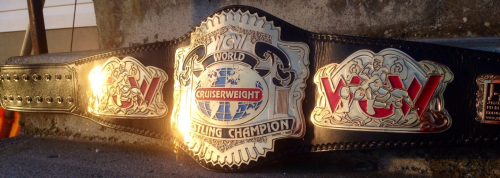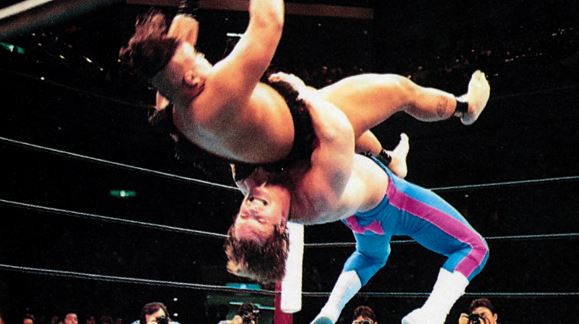
This Wednesday night on the WWE Network, the winner of the inaugural Cruiserweight Classic will be crowned during a live, two-hour special event. The past ten weeks of programming have been a real treat for any fans that have taken the time to watch, which should come as no surprise considering the quality of the talent that has participated in the tournament. This week, as the summer of the cruiserweights draws to a close, we’ll be dedicating a number of entries to the diminutive dazzlers who have changed the course of wrestling history over the past two decades, and the ones who are still changing it today – the high-flyers, mat technicians, and giant killers, from the luchadors of Mexico to the submission specialists of Calgary, the heavy strikers of Japan to the spot monkeys of the American Independents.
What better place to start than at the beginning? In March of 1996, WCW introduced the Cruiserweight Championship, a title that is among my favorite of all time. Within a year of its introduction, the Cruiserweight Championship was one of the prime reasons to tune in to Nitro every week. In an nWo-dominated landscape, the cruiserweight division brought something fresh to the table. Sensational new talents like Chris Jericho and Eddie Guerrero were being presented to American audiences on a national level for the first time, and fans of a purer style of wrestling were eating it up. With the Cruiserweight Title, World Championship Wrestling had struck gold.
The introduction of the belt, however, wasn’t the most beautifully-told story. In fact, in many ways, this is a belt that was built on lies.
On March 20, 1996, Shinjiro Otani defeated a young Chris Benoit (known then as Wild Pegasus) at an NJPW event in Nagoya, Japan. The match was the final in a tournament to crown a champion for WCW’s newly introduced cruiserweight division. It earned 4.5 stars from Dave Meltzer, and by all accounts, is one of the best matches either man has ever competed in. Despite this, the circumstances surrounding the match were not without their problems. For starters, the contest never aired on WCW television. Also, the tournament was largely fictitious, and this, the final, was unbelievably the first match of the tournament to take place.

If this all sounds a little confusing, it’s because it was. Here’s how we got there. The tournament was first announced by Eric Bischoff while he was doing commentary on the 2/19/16 episode of Monday Nitro. The announcement was not accompanied by a bracket or list of competitors, but it was mentioned that it would be international, with a portion of it taking place in Japan. A month later, on 3/20, Otani defeated Benoit to become the first Cruiserweight Champion in a match that was aired almost immediately in Japan. WCW, having not started televising cruiserweight matches, made no mention the Otani vs Benoit matchup, and three days after it took place, they announced an incomplete list of competitors that would be participating in the now-finished tournament. Names included both Benoit & Otani, along with Dean Malenko, Jushin “Thunder” Liger, Rey Mysterio, and a number of other juniors from Japan and the States. The following night, the first tournament match was aired, in which Mr. JL, who’d later find success as Jerry Lynn, upset Dean Malenko to seemingly advance to the next round.
Nothing could be taken for granted in WCW though, and the rules for this tournament changed as it progressed. For the next several weeks, the tournament was scarcely mentioned on WCW programming, but it wasn’t completely abandoned. On an April edition of WCW Saturday night, Eddie Guerrero (who had not yet competed in the tournament) defeated Mr. JL, eliminating him. Later that night, Brad Armstrong defeated Dean Malenko, who’d already lost, in another tournament match. It was then that WCW fans were told that this was a double elimination tournament. Neither Eddie Guerrero (1-0) or Mr. JL (1-1) competed in another tournament match. At least some semblance of order was being presented, though, as the tournament finals were announced for the May pay-per-view, Slamboree.
A couple of weeks later, on an episode of Nitro, commentators acknowledged that the Benoit vs Otani match had happened as part of the tournament, only stating that Chris Benoit (a Canadian) had represented America against the Japanese Shinjiro Otani and lost. The fact that this was the tournament final, or that it happened a month earlier, was completely ignored. They also stated that as a result of his victory, Otani would head to the finals to take on one of Bobby Eaton, Brad Armstrong, or Eddie Guerrero. The logistics of having one guy advance to the finals with three variables as his possible opponent do not make much sense, but even beyond that, Bobby Eaton hadn’t even competed in the tournament…yet. The following week on WCW Saturday Night, Eaton defeated a jobber by the name of Steve Doll, thus qualifying him to be one of the finalist. The match was pre-taped, which explains the mention of his victory five days earlier. On the same show, Chris Benoit, who was already announced as eliminated, advanced past Alex Wright in a tournament match.

So, as it stands, the finalists in this tournament are Bobby Eaton, Brad Armstrong, Eddie Guerrero, and Shinjiro Otani, with one of the first three taking on Otani in the finals. Chris Benoit just won a tournament match after the finalists were announced. Mr. JL has as many tournament victories as anyone else but has been long forgotten. The actual finals took place two months ago when Otani defeated Benoit, and the announced finals are going to be held at Slamboree.
And that was it.
No tournament final ever came at Slamboree. There were no other televised tournament matches at all, as a matter of fact. Rey Mysterio Jr. and Psicosis, international stars who were advertised to debut during the tournament, never showed up. Eric Bischoff quite unceremoniously announced Otani as the winner and first Cruiserweight Champion during the first Nitro of May, weeks before Slamboree. The 4.5 star clinic between he and Benoit was lost to history. Then, if you can believe it, the situation managed to get even more convoluted.
When Bischoff announced Otani as the winner of the tournament and new Cruiserweight Champion, he’d already lost the belt. Four days prior, at a WCW Worldwide taping, Otani made his only appearance as Cruiserweight Champion. Tony Schiavone inaccurately reported that he defeated Brad Armstrong in the tournament final – a match that never took place. Accompanied on that episode of Worldwide by manager Sonny Ono, Otani lost the belt to Dean Malenko, the man who went winless in the tournament to crown the first champion. Malenko would of course go on to be one of the best champions the division would ever see. Otani, well, he’d never be seen in WCW again.
And that, friends, is how the Cruiserweight Championship was born. Although it hasn’t been officially announced, one has to imagine that a new iteration of the title will be introduced to Raw next week in conjecture with the re-launch of the division. This time, however, there was an actual tournament that the world was able to see with their own eyes leading up to Wednesday’s finale, which is a lot more than can be said for the title’s original incarnation.












[…] with it, as did Chris Jericho and Ultimo Dragon. Today, cruiserweights rule the indies. Despite its questionable beginnings, the Cruiserweight Championship has become an important part of North American wrestling, and […]
Comments are closed.